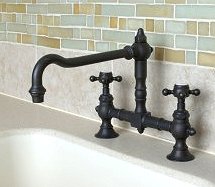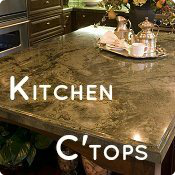Kitchen Faucets
Kitchen faucets are among the hardest working fixtures in your home. Along with the kitchen sink, the faucet gets used countless times per day and should be durable enough to provide years of dutiful service.
The right faucet can also add beauty and style to your kitchen but as a hard-working member, it needs "the right stuff" to ensure it provides trouble-free operation day after day.
Comfort and ease of use are other important features to look for because you'll use it so often.
Choices are plentiful, particularly when you consider all the combinations of design style, finish and handle configurations.
More important than style however is functionality and durability. You'll want to take some time to learn about the latest options and technologies that come with today's faucets to make sure you find one that meets your needs.
Discovering What Your Choices Are
Choosing a kitchen faucet requires a blend of your own personal taste and style, a little bit of "technical" knowledge and an understanding of what you'll ask of your new fixture. With regard to the latter, it could mean something as simple as "bringing the water to the sink" or something more complex like convenient on-and-off features or versatility for multi-function use.
Whatever your desires might be, spend a bit of time getting familiar with both the functional and aesthetic features so that you'll ultimately make good buying decisions.
Faucets 101
There's more to a kitchen faucet than just its finish and handle configuration. Getting to know the differences among the the various technologies will do two things: first, it'll help you understand faucet specifications and descriptions when you see them, and second, it will help you determine which particular type of faucet works best for you, based on your needs and budget (because not all products are created equal).
To get a good handle (pardon the pun) on understanding what there is to know, let's break them down into 4 key factors:
- Configuration
- Style
- Finish
- Construction and Valve Type
Configuration
A faucet's configuration refers to things like quantity of handles, mounting style (wall or sink/countertop) and spout structure (conventional or pull-out/pull-down).When choosing a faucet, you'll need to decide whether you want a two-handle or a single lever configuration. Two-handled faucets generally have a more traditional look and provide one handle each to operate the hot and cold water.
 Two-Handle Gooseneck Faucet with Side Sprayer
Two-Handle Gooseneck Faucet with Side Sprayer
A single-lever faucet combines the operation of hot and cold water together through the operation of a lever. The orientation of the lever will govern the amount of water coming out of the spout as well as the temperature.
The number of handles and any options like side sprays and filtered water dispensers will also determine the number of holes required in your sink, your countertop, or both.
For example, a single-lever faucet with no additional accessories requires only one hole whereas a faucet with two handles and a side
 Single-Lever Pull-Out Faucet
Single-Lever Pull-Out Faucet
The mounting style refers to where the faucet is mounted: on the countertop deck or on the wall. Wall mounted faucets include both the primary faucets as well as specialty items like pot fillers.
The key point here is that how your faucet is mounted will determine where the associated plumbing needs to be. If you're just replacing an existing faucet with no additional remodeling plans you'll need to stay with the original location. If you're doing more extensive remodeling or building new, you have a choice of mounting configurations.
Style
The style of faucet refers primarily to its functional and aesthetic design. It's a safe bet that this factor is usually the primary determinant in choosing a faucet, at least initially. When you start shopping the typical tendency is to look for a style that appeals to you and then proceed to the other deciding factors. Bridge Style Faucet
Bridge Style Faucet
Style features to consider include things like spout design (conventional, gooseneck), lever locations for single handle faucets (on the side, behind the spout), faucet handle shape and size (smooth, multi-lobed, minimalist) as well as design motif like traditional, contemporary or commercial/professional style.
Even how a kitchen faucet is styled has some bearing on its function. Conventional spouts, the kind that project out are roughly a 45-degree angle, usually have good reach but may be limiting when trying to fill large pots. Gooseneck faucets on the other hand typically to a better job accommodating large cook pots because of the higher location of the spout opening relative to the sink.
Finish
Faucet finish refers to the surface coating that you see on the spout and handles. It provides both a protective coating and decorative appeal.Their are numerous kinds of finishes and they include chrome, brushed nickel, bronze, hand-rubbed bronze, stainless steel, brass and others.
 Bridge Faucet in Rubbed Bronze Finish
Bridge Faucet in Rubbed Bronze Finish
Beyond these "color related" coatings is the process by which some of them are applied. More and more faucets today receive a "PVD" finish, which is just a fancy acronym for a less-understandable process called "physical vapor deposition".
In short, this space-age process deposits metallic ions in vaporous form on the surface of the faucet. High tech aside, the practical aspect is that it provides a very tough surface protection, making the faucet very resistant to corrosion, tarnish and even scratching.
In contrast, certain finishes that are meant to "age" like hand-rubbed bronze, don't have a PVD finish. Chrome faucets don't usually have them either
 Colored Faucet
Colored Faucet
Another type of faucet finish includes colored coatings, usually applied using a powder-coating process that's baked on. They offer an alternative to the metallic finishes.
Faucet Construction and Valve Type
A faucet's construction involves what it's made from, how it's made and the type of valve it uses to control the flow of water. All the beauty and style aside, this is what determines how well the faucet operates and how long it will last.Kitchen faucets are made from stainless steel, brass and even plastic. Plastic can come in non-metallic colors, but in the long run, it's durability won't compete with a good brass or steel faucet.
Brass faucets come in two varieties: cast brass and tubular brass. Of the two, cast brass is typically thicker and more robust than tubular brass. Brass also needs to be coated to prevent tarnishing. Common coatings include chrome plating as well as any of the PVD coatings mentioned above.
Stainless steel offers strength and durability, combined with excellent corrosion resistance. It also provides a good match to kitchens with stainless appliances and/or sinks.
The mechanism that actually controls and delivers the water through the faucet is the faucet valve. If there's any part of the faucet that might eventually wear or cause problems, it's the valve.
There are four types of faucet valves: compression, ball, cartridge and ceramic disk. The important distinction between these types of valves is the relationship between their construction and their overall level of reliability (in other words, how long before you have to get your faucet fixed).
|
Compression valve faucets are noticeable by separate hot and cold water handles. They're the oldest and simplest form of valve, controlling the water by turning a screw-like handle that compresses a valve against a seal, usually a rubber washer. These valves tend to wear out the fastest, causing drippy faucets. However they're usually easiest to fix. Ball valves are used with single lever faucets. Slots within the ball valve regulate and mix the hot and cold water flow through the back and forth, side to side motion of the lever on top of the valve body. These valves don't have washers but do have more parts making them a bit more complex. Cartridge valve faucets utilize a brass and plastic cartridge that's more reliable than the washer system used in compression faucets. They're also less complex than the ball valve which means fewer chances of problems and easier repair when something does go wrong. Ceramic disc faucet valves use two highly polished and very hard ceramic disks that slide across each other. This movement controls the water flow by opening or restricting the passage of water through openings in the disks. This type of faucet construction is considered the most durable and long-lasting, though it is more expensive than the others types. |
Considerations To Think About Before You Choose
Now that you're a little more familiar with the particulars of a kitchen faucet, let's take a look at some basic considerations you should think of when choosing one.
- Choose A Faucet And Sink Together (When Possible)
Choosing a faucet and sink together can avoid potential problems that could arise if the two decisions are made independently. Foremost is the fact that the sink needs to have sufficient holes to accommodate the faucet configuration you choose. By the same token, your countertop will need to match as well, if your faucet will be mounted on the countertop surface.If you're just buying a new faucet, then your options will be limited by your existing sink configuration.
Bottom line - choose a faucet and sink that will work together in order to avoid headaches and product returns later on.
- Single-Lever Faucets Offer Several Conveniences
Single-lever faucets leave one hand free to hold dishes, food or whatever, while the other adjusts the water control. Two-handled faucets require you to use both hands to turn on the water and regulate temperature (or use one hand to operate one handle, then the other).Fewer requirements for faucet holes (as with a single-handle faucet) also mean fewer holes to be drilled in a countertop, making for a slightly easier and cheaper countertop installation, particularly if your countertops are stone.
- Choose A Faucet Size That Complements Your Sink
The size of your kitchen faucet should be in proportion to the size of your sink. A large faucet will tend to overpower a small sink while the reverse is true when a small faucet is used with a large, three-bowl sink (not to mention the fact that the faucet might not have adequate reach over a big sink). Which brings us to.... - Make Sure The Faucet Has Adequate 'Reach'
The faucet you choose should sufficiently cover your sink, meaning that it can swing in an arc large enough to dispense water to a good portion of the sink's basin(s). The faucet's reach is determined by the horizontal distance from the spout opening to where it connects to the sink or countertop.This really isn't a problem with pull-out and pull-down faucets since these features effectively increase the range of where the water can be delivered.
- Choose Your Faucet Before Your Countertops (Where Possible)
Custom countertops require the knowledge of how many holes your faucet configuration needs ahead of time. That doesn't mean extra holes can't be drilled after the countertops are installed but it may require more hassle and cost than if they're made and installed pre-drilled for the kind of faucet you'll install. Note How Faucet & Accessories Come Through Ctop and Sink
Note How Faucet & Accessories Come Through Ctop and Sink - Colored Faucets May Be Plastic
If you're browsing colored faucets, keep in mind that some may be made out of plastic. That's OK if you're OK with it. But if you're looking for longevity, choosing a faucet made from steel or cast brass will be your best option. Sometimes it's not explicitly clear whether a colored faucet is plastic or metal. Make sure you read the accompanying descriptive information carefully to know for sure. - ADA Compliant Faucets
Faucets that comply with the ADA (Americans with Disabilities Act) are typically marked as such. These faucets comply with the ADA Accessibility Guidelines (4.27.4) that specify the requirements for controls and operating mechanisms. In other words, the faucet must be operable with one hand and cannot require tight grasping, pinching or twisting of the wrist and must be operable with a force no greater than 5 pounds. - Know/Understand Delivery "Lead Times"
Unless you choose a faucet off the shelf the product you want may have a 'lead time' which is the time it takes between actually ordering it and getting it in your hands. This is true both when ordering online and sometimes through a bricks-and-mortar supplier. Keep this in mind relative to the timing of other facets of a kitchen remodel so the faucet won't be holding up any aspect of the project. - Getting A Feel For The Faucet
Getting to know the feel of operation of various kitchen faucet configurations can help with the selection process. That doesn't mean you necessarily have to feel every type you're interested in. But understanding that you prefer single lever faucets with larger, more rounded handles vs. smaller handles that can poke you will help you gain long term satisfaction with your purchase.

|

|
| Which Faucet Handle Might Feel Better To You? |
Get Familiar With The Technologies & Innovations
Kitchen faucets have truly developed into one of the key tools of the kitchen and while its primary purpose is still to deliver the water, today's faucets do so with an amazing array of conveniences and functional options.
So before you make your final faucet decision, make sure you're up to speed on the various features and technologies that are available.
- Adjustable Height Faucets
The ability to move the faucet up or down can be a huge convenience for several reasons. Do you have really tall pots to fill? Press a button and slide the faucet 'spout' up. Don't want a lot of splashing in the sink? Slide the faucet down to it's lowest position. Pfister's Elevate™ EXT faucet is the one that can do this. It's available with 3 different height settings. All you need to do is push a button and extend or lower the faucet. - Water Filtration Faucets
How tasty (or clean) is your drinking water? Installing a kitchen water filtration faucet can help take care of those problems. These types of faucets are used in conjunction with a water filtration system, usually a filter cartridge that installs below the sink. They're a specific kind of faucet (also known as a beverage faucet) that is designed to be compatible (in other words, to hook up correctly) with the filter unit. Filters need to be replaced periodically. - Motion Sensors/Hands Free Operation
Hands-free faucets provide added levels of convenience. Got raw chicken juice all over your hands? No need to gunk up the faucet handle. Simply run your hands in front of the faucet to turn on the water and wash them off.Motion detectors are operated by a remote electronics package that operates off of household current or batteries (battery power will work during a power outage whereas systems tied into the home's electrical system won't). Water temperatures and flow times can be pre-set giving you additional control over faucet operation.
- Touch-Sensitive Operation
If motion sensing faucets don't appeal to you, how about touch sensitive faucets? The Touch2O faucet from Delta and the Pascal product from Brizo turn on and off with just a touch to the handle or the spout. It's another way to avoid contaminating the handle from soiled hands because you can just touch the spout with your wrist or forearm to control the water. They're also helpful for children who may not be able to reach the faucet handle but can reach the spout. - Pull-Down, Pull-Out and Pull-Off Faucets
Taking the concept of the old side spray a few steps forward, these faucets provide a removable spout head connected to a hose that snakes through the spout, greatly increasing the reach and accessibility of the faucet stream. Pull-Out Faucet with Spray Head On/Off Button
Pull-Out Faucet with Spray Head On/Off ButtonPull-down and pull-out faucets differ primarily in the orientation of how the spray head comes out of the faucet spout but both serve the same purpose.
Hornbeam Ivy makes a "pull-off" style in which the gooseneck spout is really just a channel that houses a steel braided hose with a spray head. The gooseneck doubles as a receptacle for the hose as well as a conventional "spout" when the hose and spray head are placed back in the spout's channel.
- Variable-Flow Heads
Many faucets are now designed to conserve water and that's achieved by regulating the water flow through the faucet head. However there are times when you just need a higher flow for filling pots and similar tasks. Having a kitchen faucet with a variable-flow head like Delta's faucets with Multi-Flow™ technology gives you the flexibility to quickly switch back and forth between different flow rates. - Easy-Clean Surfaces
Surface coatings like the EverClean™ from American Standard offer a finish that resists spotting and soiling and enables easy cleaning with a dry cloth. Coatings like these make your faucet look clean longer between your actual 'scheduled' cleaning times. - High Temperature Limit Stops
Some products like the Kohler Forte® incorporate a temperature limit stop that allows you to set the maximum temperature to eliminate the risk of scalding. The stop restricts the movement of the handle so that it's impossible to run water that's too hot. Delta DIAMOND valve faucets also possess this feature. - Aerator Faucet Heads
These nifty faucet heads add air to the spray stream for a more gentle spray when you need it. Use it for washing fragile fruits or other delicate items or just when you don't want as much splash. - Water Conserving Faucets
Faucets like the Grohe Ladylux with WaterCare technology use less water without conceding any reduction in water pressure or flow. - Commercial and Pro-Style Kitchen Faucets
Commercial style faucets are available to add to the arsenal of commercial grade kitchen appliances and fixtures. Characterized by pull-down sprays and high gooseneck styles for clearance, these faucets make for a serious kitchen. Professional Style Faucet
Professional Style Faucet - High Style
If you're looking for something unconventional and willing to spend more than what the average kitchen faucet costs, there are cutting edge designs that await you. Kohler's Karbon faucet is an articulated design with a "spout" (better described as the 'tube that delivers the water') with 5 joints. You can bend it and position it just about wherever you need to and then fold it back up when you're done with it (or just leave it as it is).The Price Pfister Kenzo faucet is another style departure with an open, squared-off U-shaped channel for a spout. You'll pay more for these design innovations but you're at least guaranteed that your kitchen will be a style leader.
Other Articles That Might Be Helpful...
If you'd like some specific information about shopping for Delta faucets check out the article on that subject. You'll see what specific features and benefits these products offer as well as get some shopping recommendations too. (Just click on the image below).
 |
 |
If you need help choosing a kitchen sink to go along with the faucet, see the articles highlighted below.
 |
 |
 |

|












Publisher's Comments --
Choosing & Shopping For A Faucet
Faucets are a blend of aesthetics and functionality. You want something that looks nice but that also works well for you. There's a huge variety of choices out there and while it might seem a bit overwhelming it doesn't have to be. The following steps provide some guidance in pulling this all together.
Get clear on the types of faucet styles you like including color and finish. Consider how your choice blends with your kitchen's style.
Once you've narrowed down some styles, determine whether you want to spend for more reliable valve technology (like ceramic disks) and if you want features like pull-down attachments, etc. Do you want single-handle functionality or a two-handle configuration? Consider how often the faucet will be used and who will use it to help make these decisions.
If you're just replacing an existing faucet, you already have the sink and know that you'll need a faucet configuration to match (in other words the faucet doesn't require more access holes than your sink currently has).
If you're buying a new faucet and sink, such as during a kitchen remodel or for a new home, make sure the two are compatible, both functionally and aesthetically (one doesn't overpower the other and the sink has the correct number of holes for the faucet).
If this if part of a kitchen remodel or some larger project, understand when you'll need (or want) to install the faucet because there may be a time lag between ordering one and getting it.
Decisions don't have to be that excruciating. If you've actually thought about the considerations above and used some form of process like this, you've done your homework. Feel good about your choice and enjoy your new faucet.